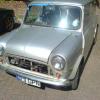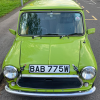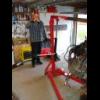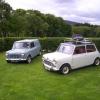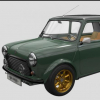I recommend getting a good book on welding from the library. That is where I learned of backing bars, many years ago. There may be a few more tricks that you will find useful. But I will try to give some explanation on the use of a backing bar.
Molten steel does not stick to copper or silver. Both of these metals conduct heat so well that they do not melt if used behind a MIG seam. Seam welds suffer from burnthrough because the heat buildup is excessive if more than a very short run is attempted. Putting all these facts together, a fairly thick copper bar can be put in tight contact with the back of the joint. It will add support to the molten metal, to prevent it collapsing, conduct heat away, again with the same effect, and form the back of the seam the way you want it to look. I suggest a shallow rounded groove, depth less than the radius otherwise the copper will mechanically lock on the seam as it cools. A rectangular groove is also usable, maybe 4mm wide by 2mm deep. The groove runs the length of the bar. Some use a flat bar and get a flat back to the weld, but a slightly raised bead is stronger and in my opinion looks more professional.
You can hold the bar against the joint by something like a jack from below, weld from above. Or put a harrow slot in both ends and use a pair of extended Intergrips, as you might use for clamping the panel edges together. Oh, and you will want a gap of the metal thickness, approximately.
The bar can be some electrical bus bar, maybe an inch wide by a quarter thick, larger if you like, and a bit longer than the amount of weld you will want to do at once. Some people actually just flatten old copper water pipe. but a fresh piece of bar is preferable. Ideally groove it on a milling machine, but a burr in a Black and Decker on a stand with a guide will do, copper is not hard. I suspect that a woodworker's router with a carbide cutter might also be up to the job, if extreme care is taken.
If your bar is 300mm long, plus a bit at each end, you might want to weld 0-75mm, 150mm-225mm, 75mm to 150mm, 225 to 300mm to spread the heat as is usual with all forms of welding rather than a continuous 300mm run. And I am not kidding, that much continuous weld in 0.9mm sheet is possible with a backing bar.
There is little heat spread away from the seam, so not much thermal expansion and subsequent contraction, except longitudinally in and very close to the weld bead. To avoid distortion you may need to stretch the seam slightly. Drop the copper bar off as soon as the weld is done (HOT!) and hammer gently along the seam only, against a dolly. It is easier when the metal is still hot.
There is a different trick where one side of the weld will not be accessible after it is done, and it is of major structural importance, such that full weld penetration, which you can't see, is essential. You use a permanent narrow steel backing bar, and leave a gap at the joint so you can see that the weld metal is wetting all 3 surfaces. You fill the joint up flush, plus a little bit. I would be inclined to use that method to fit a new end section to the main bulkhead crossmember, if I had to. A highly skilled welder does not of course have to do that, but most of us here are only occasional welders.
Those with adequate machining facilities may care to think about making a water cooled backing bar. These are used in production of quite large and heavy structures sometimes. The use on a Mini would be so that you could do a length of weld and not have to wait for ages for it to cool before moving to the next length.




